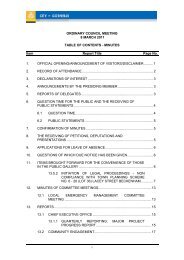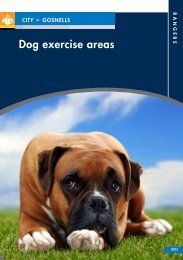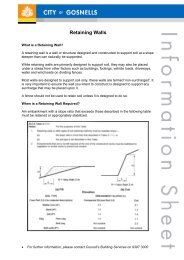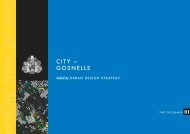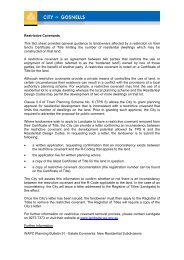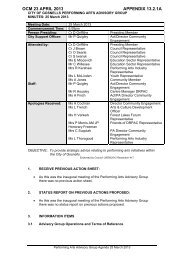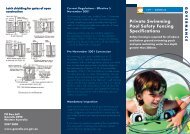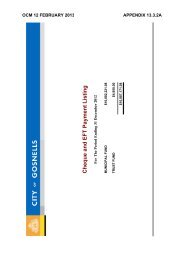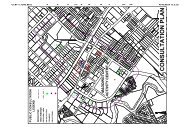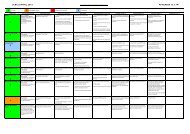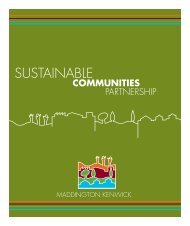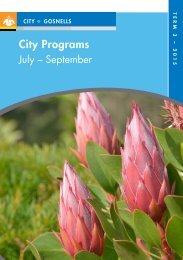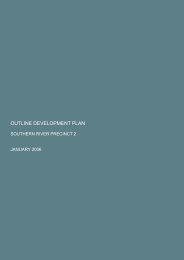Summary - City of Gosnells
Summary - City of Gosnells
Summary - City of Gosnells
You also want an ePaper? Increase the reach of your titles
YUMPU automatically turns print PDFs into web optimized ePapers that Google loves.
Vegetation 65Small areas <strong>of</strong> this vegetation inhabited seasonally waterlogged slopes <strong>of</strong> humic sand to peaty sand (betweenseasonally waterlogged or inundated clay flats and low dunes) in Precincts 1 and 2. This vegetation gradedupslope into either Melaleuca preissiana low woodland and degraded Banksia menziesii low woodland orCorymbia calophylla low forest.Associates <strong>of</strong> this vegetation included: Banksia littoralis, Burchardia bairdiae, Calandrinia sp. Kenwick(G.J. Keighery 10905), Drosera nitidula, Eutaxia virgata, Grevillea pinnatifida subsp. pinnatifida,Hydrocotyle diantha, Hypocalymma angustifolium Mud Habitat Variant (C.Tauss 1850), Juncuscaespiticius,*Lotus subbiflorus,U Lepidosperma longitudinale, UMeeboldina roycei, Melaleuca preissianaU,Microtis atrata, Schoenus asperocarpus, Schoenus discifer, *Parentucellia viscosa, Patersonia occidentalisvar. angustifolia, Pimelea imbricata var. major, Schoenus rigens, Tremulina tremula, Tribonanthes australis,Verticordia densiflora subsp. densiflora, Verticordia lindleyi subsp. lindleyi, Viminaria juncea.Vegetation Unit SL6: Hypocalymma angustifolium and other low, open to mid-dense shrubs over alienunderstorey. This was a degraded vegetation unit that was probably originally similar to other units such asSL2 or SL3. A number <strong>of</strong> areas <strong>of</strong> this vegetation unit in Precinct 2 were interspersed amongst vegetationthat was in better condition.Vegetation Unit SL7: Tecticornia indica subsp. bidens - Tecticornia lepidosperma low open shrubs overother succulents and naturalised alien grasses and herbs understorey. This was a very degraded vegetationunit that was probably originally similar to ST4. Areas <strong>of</strong> this vegetation in Precinct 2 were interspersedamongst vegetation that was in better condition.Vegetation Unit RS1: Meeboldina cana - Chaetanthus aristatus mid-dense, species-rich rushes, sedges andopen herbs and patchy Viminaria juncea tall open shrubs.This vegetation inhabited muddy floodplains in Precinct 2. It was generally in very good to good condition.There were also some areas where grazing and trampling <strong>of</strong> soils appeared to have allowed weed invasionand the regrowth was less species-rich.There were also much smaller, much more degraded stands <strong>of</strong> this vegetation in Precinct 1.Associates <strong>of</strong> this vegetation included: Acacia lasiocarpa var. lasiocarpa sens. strict., Acanthocarpuscanaliculatus, Baeckea sp. Perth Region (R.J. Cranfield 444), Angianthus preissianus, Baumea arthrophylla,Brachyscome pusilla, Burchardia multiflora, Calandrinia sp. Kenwick (G.J. Keighery 10905), Centrolepisaristata, *Cicendia filifolia, Drosera gigantea subsp. gigantea, Drosera glanduligera, Drosera menziesiisubsp. menziesii , Drosera rosulata, Drosera tubaestylis, *Eragrostis curvula,*Ehrharta calycina, Eutaxiavirgata, Gahnia trifida, Goodenia micrantha, Goodenia pulchella sp. Coastal Plain (M. Hislop 634) p.n.,Hakea varia, Hypocalymma angustifolium Mud Habitat Variant (C.Tauss 1850), Isolepis cernua var.setiformis, Juncus caespiticius, *Juncus capitatus, Lepidosperma rostratum, *Lotus subbiflorus, Meeboldinaroycei, Melaleuca lateritia, *Parentucellia viscosa, Pogonolepis stricta, Philydrella pygmaea subsp.pygmaea, Pimelea imbricata var. major, Podolepis gracilis swamp form, *Romulea rosea var. australis,Senecio pinnatifolius var. latilobus, Scaevola lanceolata, Schoenolaena juncea, Schoenus asperocarpus,Schoenus discifer, Schoenus odontocarpus, Schoenus pennisetis, Schoenus plumosus, Schoenus rigens,Sowerbaea laxiflora, Stylidium calcaratum, Stylidium dichotomum, Stylidium divaricatum, Tecticornialepidosperma, Thysanotus arenarius, Tribonanthes australis, Tribonanthes longipetala, Triglochin muelleri,Utricularia multifida, Utricularia inaequalis, Utricularia violacea, Velleia aff. trinervis (G.J. Keighery10429), Verticordia acerosa var. preissii, Verticordia plumosa var. brachyphylla.Table 5.4: Classification (by structure and dominant species) <strong>of</strong> Vegetation recorded in the MKSEA field surveyMap Unit& Total HaVegetation DescriptionStudy Sites(species richness)Vegetation ConditionLow Woodlands to Low ForestsT13.05Corymbia calophylla low woodland to low open forest overXanthorrhoea preissii and/or Kingia australis, low shrubs andCyathochaeta avenacea - Mesomelaena tetragona rushes andsedges.Sites 17 (31 spp.), 28(27 spp.)GoodVery good-goodTauss, C. and Weston, A.S. (2010). The flora, vegetation and wetlands <strong>of</strong> the Maddington-Kenwick Strategic Employment Area.A survey <strong>of</strong> the rural lands in the vicinity <strong>of</strong> the Greater Brixton Street Wetlands. Report to the <strong>City</strong> <strong>of</strong> <strong>Gosnells</strong>, W.A. Version 18.04.10



